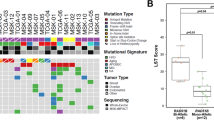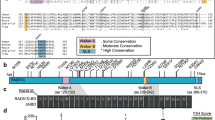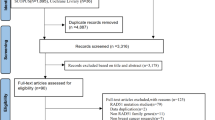Abstract
RAD51 paralogs (RAD51B, RAD51C, RAD51D, XRCC2, and XRCC3) have recently been involved in breast and ovarian cancer predisposition: RAD51B, RAD51C, and RAD51D in ovarian cancer, RAD51B and XRCC2 in breast cancer. The aim of this study was to estimate the contribution of deleterious variants in the five RAD51 paralogs to breast and ovarian cancers. The five RAD51 paralog genes were analyzed by next-generation sequencing technologies in germline DNA from 2649 consecutive patients diagnosed with breast and/or ovarian cancer. Twenty-one different deleterious variants were identified in the RAD51 paralogs in 30 patients: RAD51B (n = 4), RAD51C (n = 12), RAD51D (n = 7), XRCC2 (n = 2), and XRCC3 (n = 5). The overall deleterious variant rate was 1.13% (95% confidence interval (CI): 0.72–1.55%) (30/2649), including 15 variants in breast cancer only cases (15/2063; 0.73% (95% CI: 0.34–1.11%)) and 15 variants in cases with at least one ovarian cancer (15/570; 2.63% (95% CI: 1.24–4.02%)). This study is the first evaluation of the five RAD51 paralogs in breast and ovarian cancer predisposition and it demonstrates that deleterious variants can be present in breast cancer only cases. Moreover, this is the first time that XRCC3 deleterious variants have been identified in breast and ovarian cancer cases.
Similar content being viewed by others
Log in or create a free account to read this content
Gain free access to this article, as well as selected content from this journal and more on nature.com
or
References
Mavaddat N, Peock S, Frost D, et al. Cancer risks for BRCA1 and BRCA2 mutation carriers: results from prospective analysis of EMBRACE. J Natl Cancer Inst. 2013;105:812–22.
Antoniou AC, Casadei S, Heikkinen T, et al. Breast-cancer risk in families with mutations in PALB2. N Engl J Med. 2014;371:497–506.
Norquist BM, Harrell MI, Brady MF, et al. Inherited mutations in women with ovarian carcinoma. JAMA Oncol. 2016;2:482–90.
Easton DF, Lesueur F, Decker B, et al. No evidence that protein truncating variants in BRIP1 are associated with breast cancer risk: implications for gene panel testing. J Med Genet. 2016;53:298–309.
Bogliolo M, Surrallés J. Fanconi anemia: a model disease for studies on human genetics and advanced therapeutics. Curr Opin Genet Dev. 2015;33:32–40.
Prakash R, Zhang Y, Feng W, Jasin M. Homologous recombination and human health: the roles of BRCA1, BRCA2, and associated proteins. Cold Spring Harb Perspect Biol. 2015;7:a016600.
Meindl A, Hellebrand H, Wiek C, et al. Germline mutations in breast and ovarian cancer pedigrees establish RAD51C as a human cancer susceptibility gene. Nat Genet. 2010;42:410–14.
Loveday C, Turnbull C, Ramsay E, et al. Germline mutations in RAD51D confer susceptibility to ovarian cancer. Nat Genet. 2011;43:879–82.
Loveday C, Turnbull C, Ruark E, et al. Germline RAD51C mutations confer susceptibility to ovarian cancer. Nat Genet. 2012;44:475–76. author reply 476
Golmard L, Caux-Moncoutier V, Davy G, et al. Germline mutation in the RAD51B gene confers predisposition to breast cancer. BMC Cancer. 2013;13:484.
Song H, Dicks E, Ramus SJ, et al. Contribution of germline mutations in the RAD51B, RAD51C, and RAD51D genes to ovarian cancer in the population. J Clin Oncol. 2015;33:2901–7.
Park DJ, Lesueur F, Nguyen-Dumont T, et al. Rare mutations in XRCC2 increase the risk of breast cancer. Am J Hum Genet. 2012;90:734–39.
Hilbers FS, Wijnen JT, Hoogerbrugge N, et al. Rare variants in XRCC2 as breast cancer susceptibility alleles. J Med Genet. 2012;49:618–20.
Pelttari LM, Kiiski JI, Ranta S, et al. RAD51, XRCC3, and XRCC2 mutation screening in Finnish breast cancer families. SpringerPlus. 2015;4:92.
He X-F, Wei W, Su J, et al. Association between the XRCC3 polymorphisms and breast cancer risk: meta-analysis based on case-control studies. Mol Biol Rep. 2012;39:5125–34.
Yuan C, Liu X, Yan S, Wang C, Kong B. Analyzing association of the XRCC3 gene polymorphism with ovarian cancer risk. Biomed Res Int. 2014;2014:648137.
Castéra L, Krieger S, Rousselin A, et al. Next-generation sequencing for the diagnosis of hereditary breast and ovarian cancer using genomic capture targeting multiple candidate genes. Eur J Hum Genet. 2014;22:1305–13.
Richards S, Aziz N, Bale S, et al. Standards and guidelines for the interpretation of sequence variants: a joint consensus recommendation of the American College of medical genetics and genomics and the association for molecular pathology. Genet Med. 2015;17:405–24.
Tavtigian SV, Deffenbaugh AM, Yin L, et al. Comprehensive statistical study of 452 BRCA1 missense substitutions with classification of eight recurrent substitutions as neutral. J Med Genet. 2006;43:295–05.
Houdayer C, Caux-Moncoutier V, Krieger S, et al. Guidelines for splicing analysis in molecular diagnosis derived from a set of 327 combined in silico/in vitro studies on BRCA1 and BRCA2 variants. Hum Mutat. 2012;33:1228–38.
Claus EB, Risch N, Thompson WD. Genetic analysis of breast cancer in the cancer and steroid hormone study. Am J Hum Genet. 1991;48:232–42.
Chun J, Buechelmaier ES, Powell SN. Rad51 paralog complexes BCDX2 and CX3 act at different stages in the BRCA1-BRCA2-dependent homologous recombination pathway. Mol Cell Biol. 2013;33:387–95.
Min A, Im S-A, Yoon Y-K, et al. RAD51C-deficient cancer cells are highly sensitive to the PARP inhibitor olaparib. Mol Cancer Ther. 2013;12:865–77.
Hilbers FS, Luijsterburg MS, Wiegant WW, et al. Functional analysis of missense variants in the putative breast cancer susceptibility gene XRCC2. Hum Mutat. 2016;37:914–25.
Rivera B, Di Iorio M, Frankum J, et al. Functionally null RAD51D missense mutation associates strongly with ovarian carcinoma. Cancer Res. 2017;77:4517–29.
Ahlborn LB, Steffensen AY, Jønson L, et al. Identification of a breast cancer family double heterozygote for RAD51C and BRCA2 gene mutations. Fam Cancer. 2015;14:129–33.
Long J, Zhang B, Signorello LB, et al. Evaluating genome-wide association study-identified breast cancer risk variants in African-American women. PLoS ONE. 2013;8:e58350.
Purrington KS, Slager S, Eccles D, et al. Genome-wide association study identifies 25 known breast cancer susceptibility loci as risk factors for triple-negative breast cancer. Carcinogenesis. 2014;35:1012–19.
Buys SS, Sandbach JF, Gammon A, et al. A study of over 35,000 women with breast cancer tested with a 25-gene panel of hereditary cancer genes. Cancer. 2017;123:1721–30.
Lakhani SR, Manek S, Penault-Llorca F, et al. Pathology of ovarian cancers in BRCA1 and BRCA2 carriers. Clin Cancer Res. 2004;10:2473–81.
Gevensleben H, Bossung V, Meindl A, et al. Pathological features of breast and ovarian cancers in RAD51C germline mutation carriers. Virchows Arch Int J Pathol. 2014;465:365–69.
Figueroa JD, Garcia-Closas M, Humphreys M, et al. Associations of common variants at 1p11.2 and 14q24.1 (RAD51L1) with breast cancer risk and heterogeneity by tumor subtype: findings from the breast cancer association consortium. Hum Mol Genet. 2011;20:4693–06.
Stevens KN, Vachon CM, Lee AM, et al. Common breast cancer susceptibility loci are associated with triple-negative breast cancer. Cancer Res. 2011;71:6240–49.
Thomas G, Jacobs KB, Kraft P, et al. A multistage genome-wide association study in breast cancer identifies two new risk alleles at 1p11.2 and 14q24.1 (RAD51L1). Nat Genet. 2009;41:579–84.
Orr N, Lemnrau A, Cooke R, et al. Genome-wide association study identifies a common variant in RAD51B associated with male breast cancer risk. Nat Genet. 2012;44:1182–84.
Osorio A, Endt D, Fernández F, et al. Predominance of pathogenic missense variants in the RAD51C gene occurring in breast and ovarian cancer families. Hum Mol Genet. 2012;21:2889–98.
Coulet F, Fajac A, Colas C, et al. Germline RAD51C mutations in ovarian cancer susceptibility. Clin Genet. 2013;83:332–36.
Thompson ER, Boyle SE, Johnson J, et al. Analysis of RAD51C germline mutations in high-risk breast and ovarian cancer families and ovarian cancer patients. Hum Mutat. 2012;33:95–99.
Blanco A, Gutiérrez-Enríquez S, Santamariña M, et al. RAD51C germline mutations found in Spanish site-specific breast cancer and breast-ovarian cancer families. Breast Cancer Res Treat. 2014;147:133–43.
Schnurbein G, Hauke J, Wappenschmidt B, et al. RAD51C deletion screening identifies a recurrent gross deletion in breast cancer and ovarian cancer families. Breast Cancer Res. 2013;15:R120.
Vuorela M, Pylkäs K, Hartikainen JM, et al. Further evidence for the contribution of the RAD51C gene in hereditary breast and ovarian cancer susceptibility. Breast Cancer Res Treat. 2011;130:1003–10.
Gutiérrez-Enríquez S, Bonache S, de Garibay GR, et al. About 1% of the breast and ovarian Spanish families testing negative for BRCA1 and BRCA2 are carriers of RAD51D pathogenic variants. Int J Cancer. 2014;134:2088–97.
Osher DJ, De Leeneer K, Michils G, et al. Mutation analysis of RAD51D in non-BRCA1/2 ovarian and breast cancer families. Br J Cancer. 2012;106:1460–63.
Baker JL, Schwab RB, Wallace AM, Madlensky L. Breast cancer in a RAD51D mutation carrier: case report and review of the literature. Clin Breast Cancer. 2015;15:e71–75.
He Y, Zhang Y, Jin C, et al. Impact of XRCC2 Arg188His polymorphism on cancer susceptibility: a meta-analysis. PLoS ONE. 2014;9:e91202.
Zhai M, Wang Y, Jiang MF Arg188His polymorphism in the XRCC2 gene and the risk of ovarian cancer: a meta-analysis. Genet Mol Res. 2015;14:10808–815.
Kamali M, Hamadani S, Neamatzadeh H, et al. Association of XRCC2rs3218536 polymorphism with susceptibility of breast and ovarian cancer: a systematic review and meta-analysis. Asian Pac J Cancer Prev. 2017;18:1743–749.
Sopik V, Akbari MR, Narod SA Genetic testing for RAD51C mutations: in the clinic and community. Clin Genet. 2015;88:303–12.
Drew Y The development of PARP inhibitors in ovarian cancer: from bench to bedside. Br J Cancer. 2015;113:S3–S9.
Acknowledgements
This work was supported by INCa and DGOS in the context of the SiRIC program #2011-189.
Author information
Authors and Affiliations
Corresponding author
Ethics declarations
Conflict of interest
The authors declare no conflict of interest.
Electronic supplementary material
Rights and permissions
About this article
Cite this article
Golmard, L., Castéra, L., Krieger, S. et al. Contribution of germline deleterious variants in the RAD51 paralogs to breast and ovarian cancers. Eur J Hum Genet 25, 1345–1353 (2017). https://doi.org/10.1038/s41431-017-0021-2
Received:
Revised:
Accepted:
Published:
Issue date:
DOI: https://doi.org/10.1038/s41431-017-0021-2
This article is cited by
-
Primary fallopian tube cancer followed by primary breast cancer in RAD51C mutation carrier treated with niraparib as first line maintenance therapy: a case report
Hereditary Cancer in Clinical Practice (2024)
-
HBV promotes its replication by up-regulating RAD51C gene expression
Scientific Reports (2024)
-
Ethnicity-specific BRCA1, BRCA2, PALB2, and ATM pathogenic alleles in breast and ovarian cancer patients from the North Caucasus
Breast Cancer Research and Treatment (2024)
-
Analyzing the Expression of Ovarian Cancer Genes in PA-1 Cells Lines After the Treatment of Thymoquinone
Indian Journal of Gynecologic Oncology (2023)
-
Homologous recombination deficiency derived from whole-genome sequencing predicts platinum response in triple-negative breast cancers
Nature Communications (2023)



